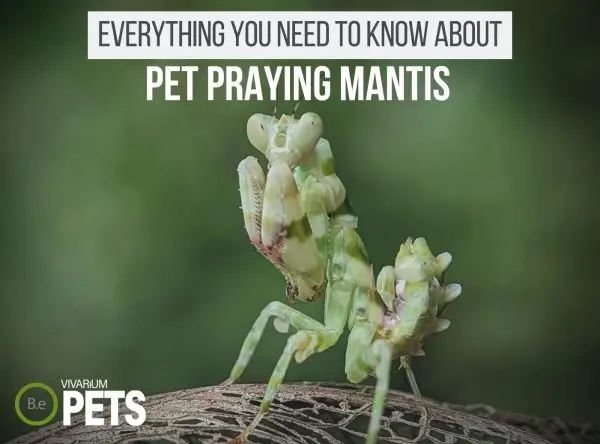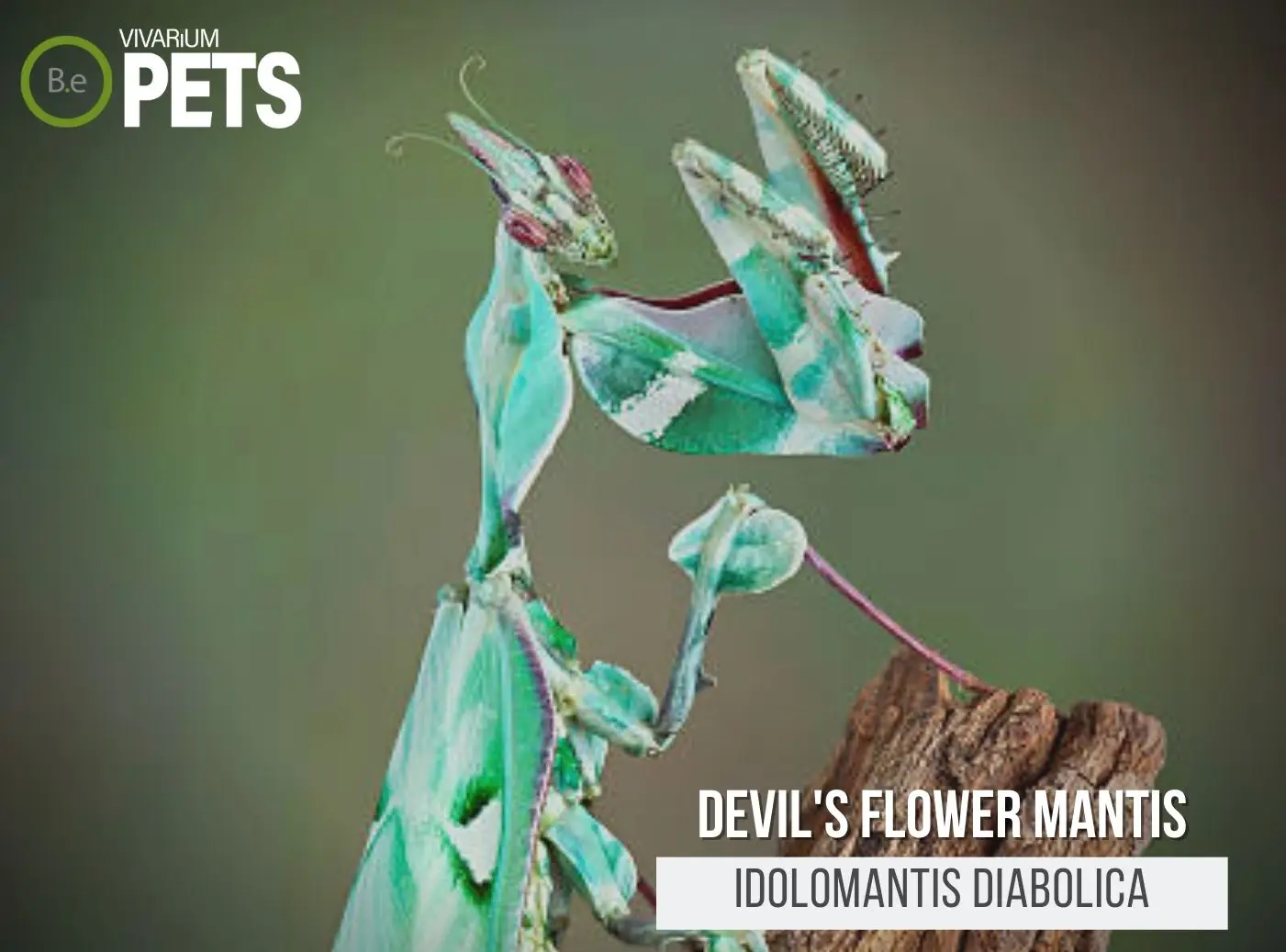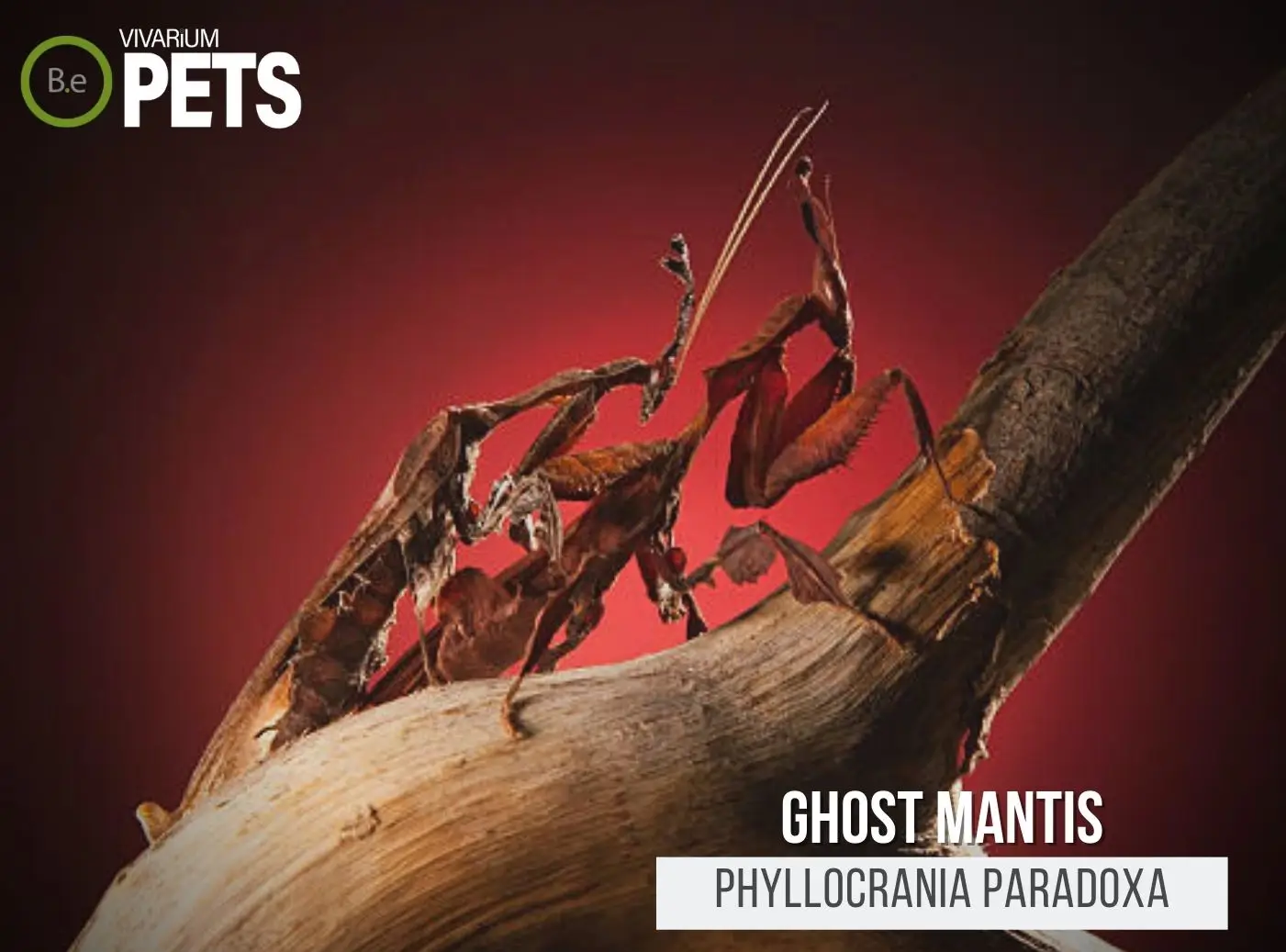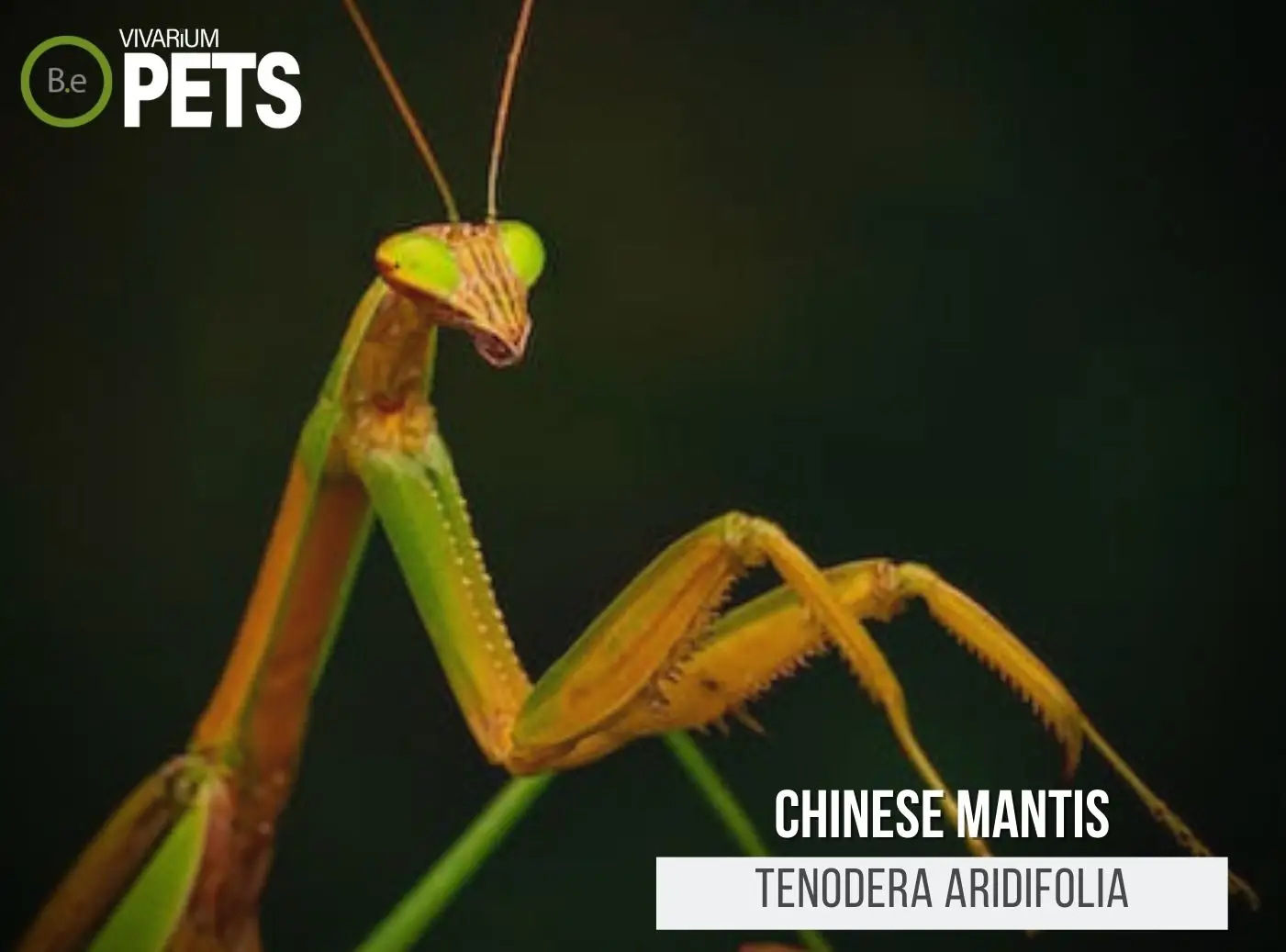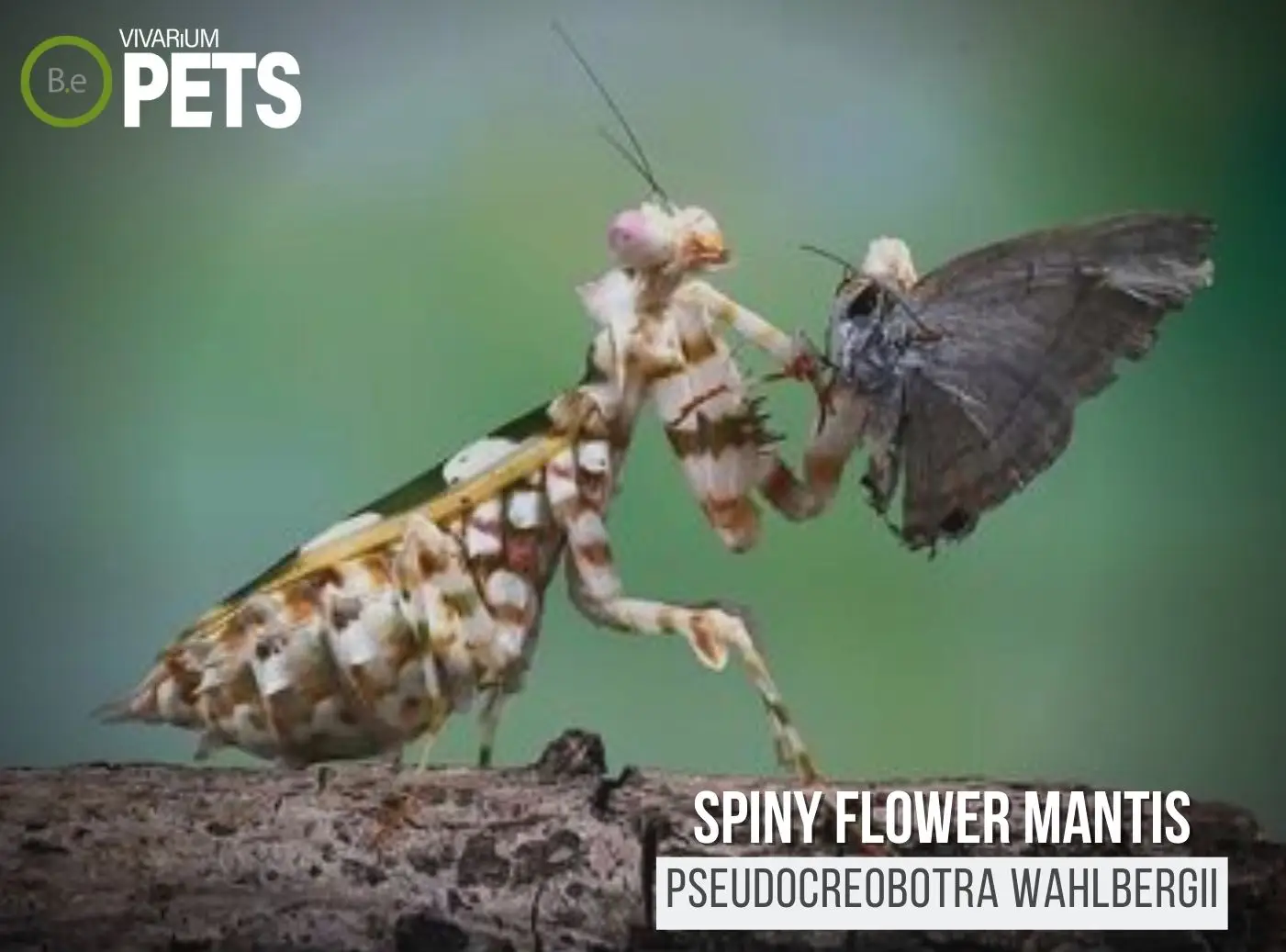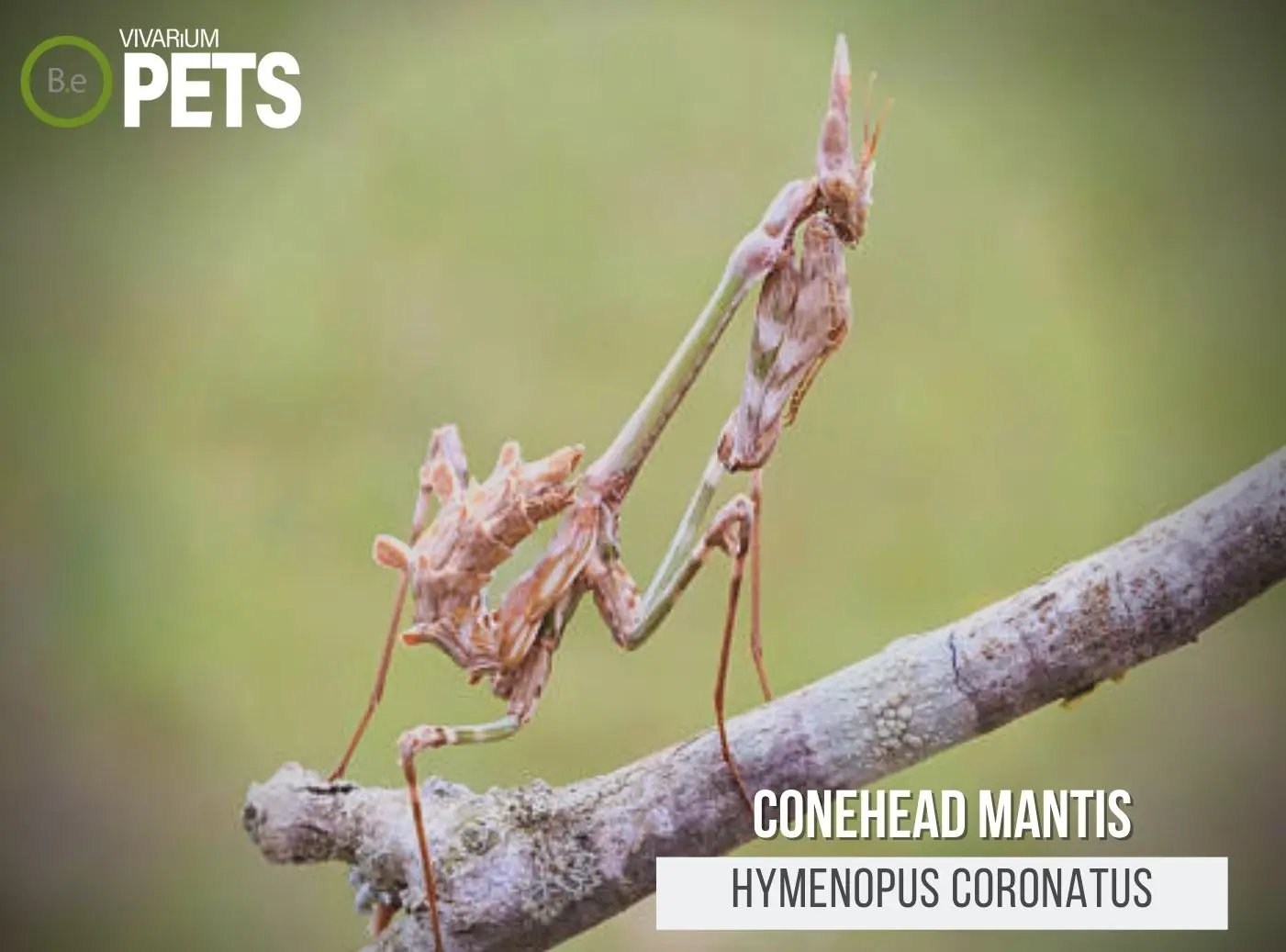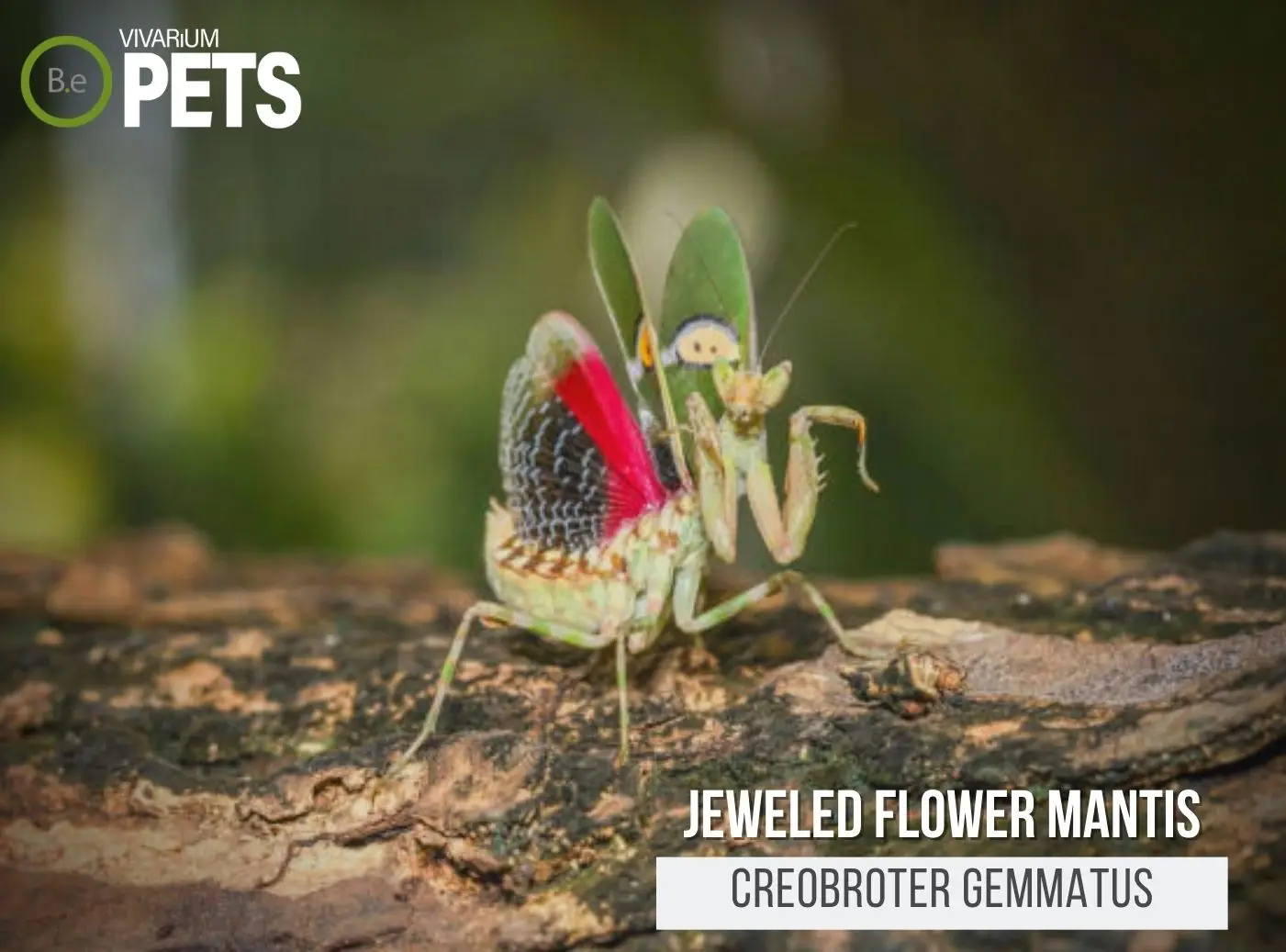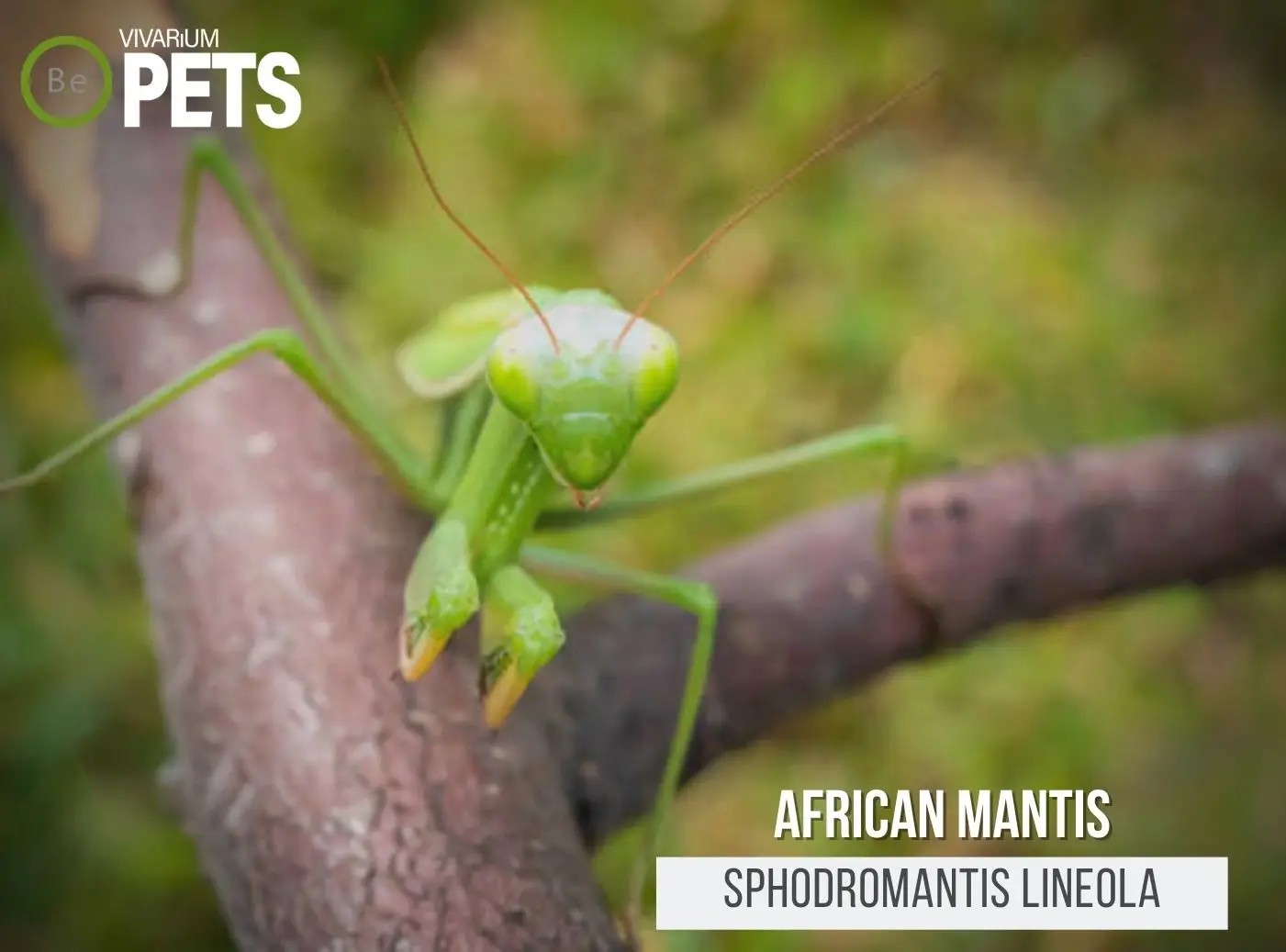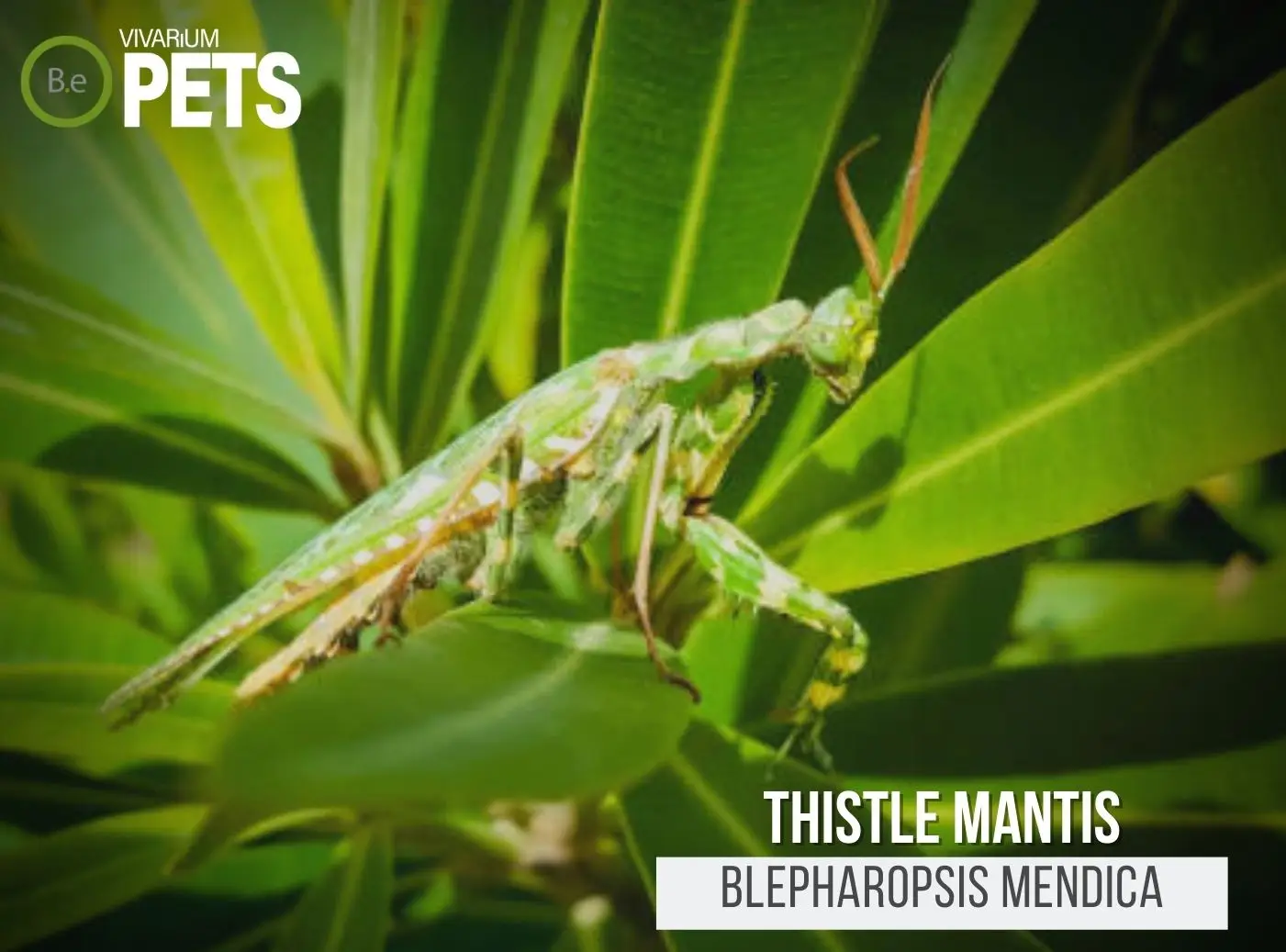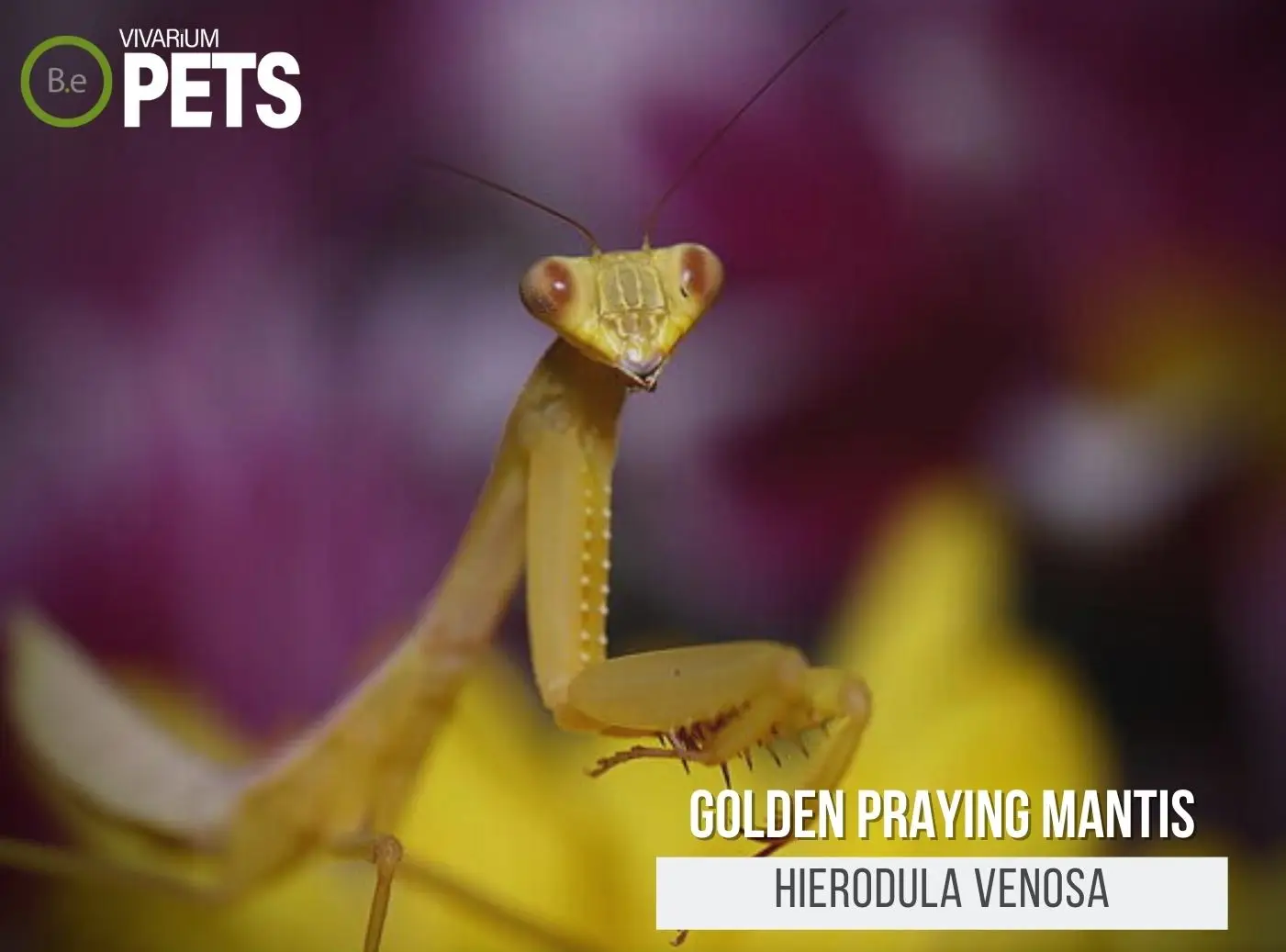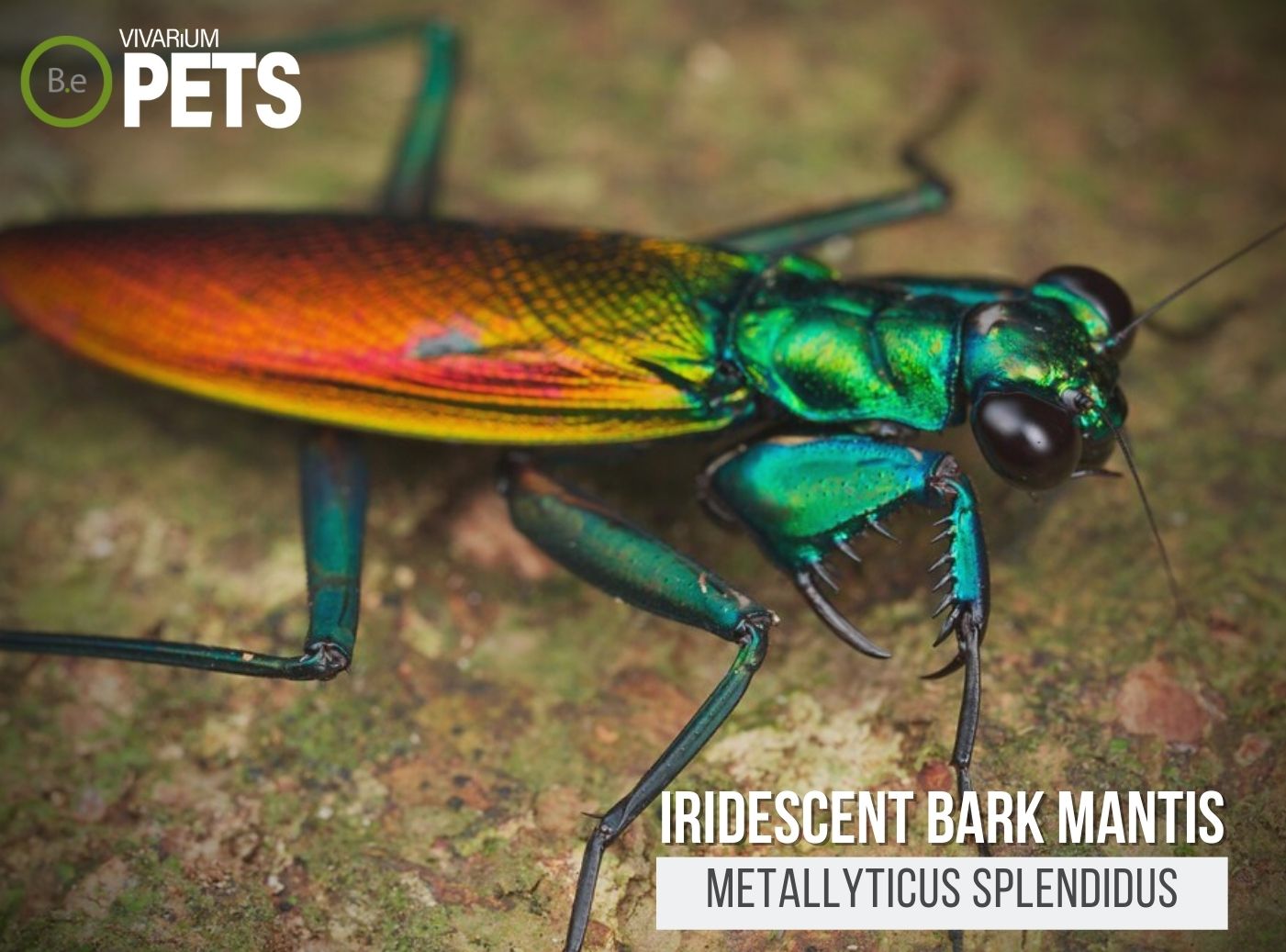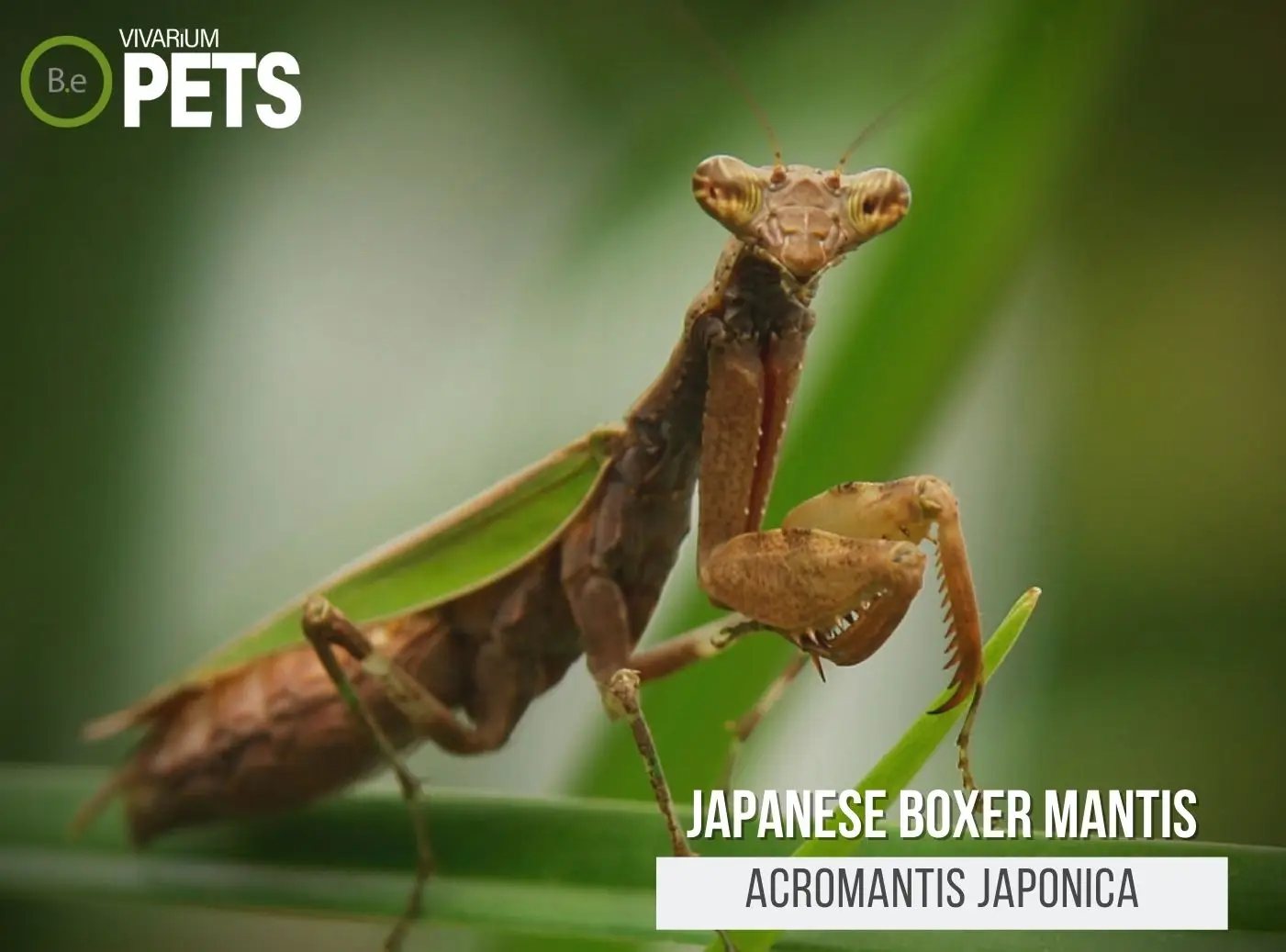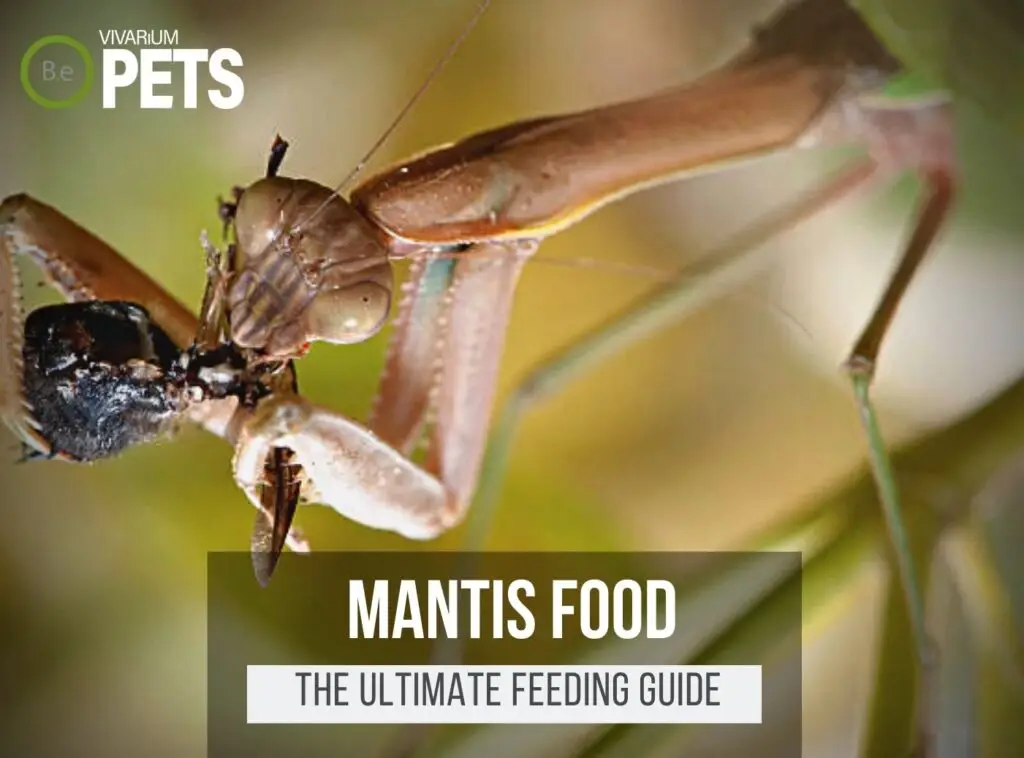If you’re looking for a one-of-a-kind companion with a delightful personality, why not consider a pet praying mantis?
With so many species, you’re sure to find a captivating variation that suits your preferences.
From impressively super-sized mantids to charming mantes that look like flowers or leaves, the options are endless.
In this article, we’ll introduce you to a few of the most unique types of pet praying mantises and provide you with guidance on how to properly care for and set up your new friend.
Table Of Contents:
ToggleWhat Is A Praying Mantis?
Praying mantises are an iconic insect that comes with many distinctive features.
Commonly recognized for their slightly frightening stance, they pray with their powerful front legs raised in their signature pose.
Another signature feature these creatures have is their ability to camouflage into nature. From dead leaf mantes to flower mantes, they are remarkable at blending into natural elements.
Interestingly, praying mantises have an unusual ability – they are the only insects capable of turning their heads 180 degrees, allowing them to survey their surroundings with ease.
They also have wide, triangular heads with highly adapted compound eyes that help them detect the movement of nearby prey.
All these special characteristics make the praying mantis a truly remarkable pet!


Benefits Of Praying Mantis
Praying mantises are suitable pets for an environment such as a terrarium since they do not take up much room and they add diversity and beauty to the ecosystem.
Additionally, they can also help both vivariums, as well as gardens, stay healthy by consuming small insects and pests that harm plants.
Plus, they are also major predators, protecting your plants from other larger preying animals.
Interestingly, they are also interactive with humans, orienting to your movements while being held or handled.
Depending on the breed, some praying mantises might even tolerate a bit of handling and cuddling.
Create the perfect home for your mantis with our Customizable Mantis Enclosure Kits, designed to meet all their habitat needs.
Best Types Of Pet Praying Mantis
If you’re planning to introduce a pet praying mantis to your terrarium, it’s essential to choose the appropriate species based on its size and care requirements.
Keep in mind that larger specimens will require more space to thrive.
Furthermore, consider the specific care requirements for each species, as some may need higher humidity levels and specialized diets.
Also, take into account the mantis’ temperament, since some are more aggressive than others.
To ensure that you can provide a suitable habitat, consult our guide for details on their natural environment.
With that being said, here’s a list of unusual praying mantes kept as pets all around the world:
European Mantis (Mantis religiosa)
The European Mantis is a fascinating pet for terrariums, offering a unique and remarkable insect experience.
These vivid green mantises, often reaching lengths of 3-6 cm, are unlike any other species;
They are known to be an example of ‘aggressive mimicry’ as their exoskeleton closely resembles leaves from the savannah, enabling them to lie in wait for their unsuspecting prey.
Their keen eyesight also helps them detect movement from afar, and they often present solutions for pest control.
With proper care and a proper living environment, these remarkable invertebrates will continue to amaze pet keeners for years to come!
If you want more specifics on this pet praying mantis, here’s a complete care guide on European Mantis (Mantis religiosa).
Orchid Mantis (Hymenopus coronatus)
The Orchid Mantis is a stunning species of mantis, with an impressive size and exquisite beauty.
Its pink and white streaked wings, rolling eyes, and brightly colored body blend to create a magical appearance that will take the breath away of any insect lover.
This unusual pet mantis not only provides a unique aesthetic but is also a great source of education and entertainment.
As the largest variety of mantis, these omnivores can reach up to more than six centimeters in size, making them the perfect pet for any terrarium.
The Orchid Mantis is a great way to observe and appreciate the intricate details of the insect world.
If you want more specifics on this pet praying mantis, here’s a complete care guide on Orchid Mantis (Hymenopus coronatus).
Devil’s Flower Mantis (Idolomantis diabolica)
The Devil’s Flower Mantis is an intriguing species known for its versatility in camouflage.
Delicate in appearance, these pet mantes display spectacular wings with intricate patterns of greens, creams, and oranges.
These small creatures are known for their ability to blend with their environment, making it easy for them to ambush unwary prey.
While Devil’s Flower Mantis won’t require frequent care, terrarium owners can enjoy observing the color-shifting of these bold insects.
If you want more specifics on this pet praying mantis, here’s a complete care guide on Devil’s Flower Mantis (Idolomantis diabolica).
Ghost Mantis (Phyllocrania paradoxa)
The Ghost Mantis is an eye-catching species of praying mantis, with an unmistakable, pale gray, ethereal appearance.
This camouflage technique helps them blend seamlessly into the bark and decaying leaves of their natural environment.
Scientists widely believe that this species has evolved its remarkable coloration to ward off potential predators.
The population numbers of this remarkable creature are currently at risk.
But with the right environment and attention, this endangered mantis can bring a captivating and shifting shade of eerie to a pet’s terrarium.
If you want more specifics on this pet praying mantis, here’s a complete care guide on Ghost Mantis (Phyllocrania paradoxa).
Chinese Mantis (Tenodera aridifolia)
The Chinese Mantis is a one-of-a-kind species of praying mantis, suitable for terrariums of all shapes and sizes.
Although they may appear fragile, these majestic invertebrates are aggressive predators with impressive wingspans and powerful forelegs.
As a species of religious rite and lucky charm, these mantids have come to symbolize strength and resilience.
With striking green coloring and fanned wings, the Chinese Mantis is a captivating pet that is both fascinating to observe and surprisingly low maintenance.
If you’re looking for more specifics on this pet praying mantis, here’s a full care guide on the Chinese Mantis (Tenodera aridifolia).
Spiny Flower Mantis (Pseudocreobotra wahlbergii)
The Spiny Flower Mantis is a daring insect, with a unique mix of camouflage and coloration allowing it to blend into its natural environments.
This eye-catching species typically displays various shades of green and yellow, mimicking the foliage it so expertly conceals.
With spines covering their limbs and antennae, these fashionable predators have a noticeable but intimidating look.
Perfect for vivariums, they enjoy the added protection and security, allowing them to search for small insects without fear.
Their unique charms and bold personalities make them ideal pets to study and observe.
If you’re looking for more specifics on this praying mantis, here’s a full care guide on Spiny Flower Mantis (Pseudocreobotra wahlbergii).
Carolina Mantis (Stagmomantis carolina)
The Carolina Mantis is a species known for their bold and fearless nature.
With vibrant green and brown mottled patterning, these mantids can camouflage into stem plants and woody foliage.
Native to the southeastern United States, these mantids usually prefer stick-like cover, making them ideal for branchy terrariums.
In addition to their impressive predatory skills, Carolina Mantids are also easily handled by hand and can make an interesting and interactive pet in anyone’s enclosure.
If you’re looking for more specifics on this pet praying mantis, here’s a full care guide on Carolina Mantis (Stagmomantis carolina).
Giant Asian Mantis (Hierodula patellifera)
The Giant Asian Mantis is a beautiful and powerful species of insect beloved by pet owners around the world.
As one of the larger species of mantis, the Giant Asian Mantis is easily recognizable by its green and brown stripes along its large body.
They are quite active and are often seen hopping around their environment looking for food.
With a gentle demeanor and sleek physique, these animals make a stunning addition to any tank.
Their powerful and impressive hunting skills make them a truly fascinating pet to observe.
If you’re looking for more specifics on this pet praying mantis, here’s a full care guide on Giant Asian Mantis (Hierodula patellifera).
Dragon Mantis (Stenophylla lobivertex)
The Dragon Mantis is a truly exotic species of praying mantis, with its famously vivid green and yellow coloring leading to its ominous name.
This little mantis offers an unforgettable show, with its delicate wings adorned in intricate patterns only just visible to the human eye.
Its small size makes it an ideal pet for smaller terrariums; allowing placement of plants, branches, and other decorations that provide the perfect environment for their larger home-bound relatives.
This species is known as a symbol of strength, resilience, and bravery, making it an excellent companion for those looking for a show of exotic beauty within their home.
If you’re looking for more specifics on this pet praying mantis, here’s a full care guide on Dragon Mantis (Stenophylla lobivertex).
Conehead Mantis (Empusa pennata)
The Conehead Mantis is an impressive species of praying mantis, with its distinct cone-shaped head and long, elegant antennae giving it an unmistakable air of sophistication.
These graceful insects come in a range of beautiful colors, including greyish-yellow, maroon, and moss green.
With its modest size, this species of mantis is an ideal pet for medium-sized ecosystems, allowing the addition of other decorations like plants and branches which provide natural living space for this fascinating creature.
The Conehead Mantis is known among praying mantis enthusiasts as a symbol of courage, resilience, and strength, and is sure to bring a unique and majestic beauty to any home.
If you’re looking for more specifics on this pet praying mantis, here’s a full care guide on Conehead Mantis (Empusa pennata).
Jeweled Flower Mantis (Creobroter gemmatus)
The Jeweled Flower Mantis graces its surroundings with regal beauty, its wings adorned with colorful spots that shimmer like tiny jewels.
This species of praying mantis sports a unique combination of red, yellow, and orange colors easily recognizable by their impressive size and bright wings.
Jeweled Flower Mantis will bring a majestic splash of color to any enclosure, as these mantes have an impressive lifespan of up to several months when properly cared for in captivity.
This species is quite docile and known for its hardy behavior, allowing you to enjoy an unobstructed view of its vivid and intricate wingspan while providing an exciting show with its twitching antennae and remarkable behavior.
If you’re looking for more specifics on this pet praying mantis, here’s a full care guide on the Jeweled Flower Mantis (Creobroter gemmatus).
Dead Leaf Mantis (Deroplatys lobata)
The Dead Leaf Mantis is an unusual species of praying mantis renowned for its remarkable camouflage.
As its name suggests, it usually looks like a dead leaf or other vegetation when it blends itself to its surroundings.
With a grey, green, and brown coloration, it uses its long slender limbs and thin wings to hide away in plain sight.
It’s an ideal pet for terrariums as its slow and methodical movements are fascinating to watch, while also being a sturdy species that can adapt to different temperatures and humidities with ease.
If you’re looking for more specifics on this pet praying mantis, here’s a full care guide on the Dead Leaf Mantis (Deroplatys lobata).
Giant Dead Leaf Mantis (Deroplatys desiccata)
The Giant Dead Leaf Mantis is a slightly larger species of leaf mantis that is also known for its unusual camouflage.
With its large, thin wings resembling dead leaves, this mantis can hide from predators in plain sight.
As one of the largest species of its kind, its wingspan can reach up to four inches in length, making it a magnificent sight to behold.
Ideal for mid-sized vivariums, owning a Giant Dead Leaf Mantis lets pet owners experience the unique abilities of an exotic animal in the comfort of their own home.
If you’re looking for more specifics on this pet praying mantis, here’s a full care guide on Giant Dead Leaf Mantis (Deroplatys desiccata).
Wandering Violin Mantis (Gongylus gongylodes)
The Wandering Violin Mantis is an impressive species of mantis, named for its unique shape resembling a violin.
With stunning brown and yellow wings, some specimens of this species boast a deep maroon hue for a captivating effect.
Predators of this species are immediately aware of its presence, as those wings wave in a threatening display thanks to its body movements.
An ideal pet for terrariums, this rare species is sure to be an impressive addition to any home, providing exciting observations from the comfort of its habitat.
If you’re looking for more specifics on this pet praying mantis, here’s a full care guide on Wandering Violin Mantis (Gongylus gongylodes).
African Mantis (Sphodromantis lineola)
The African Mantis is an incredibly unique species of mantis, known for its bright green coloration blended with yellow markings.
They hail from the Sahara Desert and are highly suited to life in a terrarium.
With a carnivorous diet including flies, caterpillars, and other small insects, they love to hunt and can provide hours of fascinating entertainment.
Not only are these agile predators an impressive centerpiece for any enclosure, but they can serve as an educational conversation starter as well.
If you’re looking for more specifics on this pet praying mantis, here’s a full care guide on the African Mantis (Sphodromantis lineola).
Thistle Mantis (Blepharopsis mendica)
The Thistle Mantis is a delightful pet for terrariums.
With its unique spiny decorations, this species of praying mantis has a strong, vivid appearance.
Its vibrant green, yellow, and cream colors make it a great centerpiece for any display.
Thistle mantises are also known for their calm demeanor, making them great for observing and handling.
Their unique abilities to move their wings and rotate their heads an almost full 360 degrees give them a character unlike any other.
With proper care, these fascinating critters can bring great joy and an appreciation of nature to any observer.
If you’re looking for more specifics on this pet praying mantis, here’s a full care guide on Thistle Mantis (Blepharopsis mendica).
Golden Praying Mantis (Hierodula venosa)
The Golden Praying Mantis is an attractive species of mantis with a vibrant yellow hue.
This species of mantis is both active and intelligent, making them a fascinating pet for any enclosure.
Not only do they make great visual specimens due to their striking color, but they also provide plenty of entertainment as they jump from place to place and interact with their environment.
Scientists believe that the coloration of this species may help to protect it from potential predators around flowers.
Any pet owner looking for an entertaining and colorful addition to their terrarium should consider the Golden Praying Mantis!
If you’re looking for more specifics on this pet praying mantis, here’s a full care guide on the Golden Praying Mantis (Hierodula venosa).
Zebra Mantis (Omomantis zebrata)
The Zebra Mantis is a vividly striped species of praying mantis native to tropical regions of Africa.
It was named for its alternating black stripes that give it a remarkable zebra-like patterning.
These mantis species are small, with adults measuring no more than 6 cm in length, and have a gentle, slow-moving demeanor.
Zebra Mantis can make for fascinating pets, as they’re beautiful to look at and relatively easy to care for, especially in terrestrial vivariums.
If you’re looking for more specifics on this pet praying mantis, here’s a full care guide on the Zebra Mantis (Omomantis zebrata).
Cryptic Mantis (Sibylla pretiosa)
The Cryptic Mantis is an entrancingly mysterious insect that appears both in grey and brown, depending on the environment.
True to its name, this species of mantis has an incredibly “cryptic” manner of camouflage, adapting to blend in with the patterns of bark, branches, or leaves.
Exotic and exquisitely beautiful, this bird-like mantis is both fragile and fearsome when provoked.
Ideal for small tanks, the Cryptic Mantis is a joy for any pet aficionado looking for an unusual yet docile companion.
If you’re looking for more specifics on this pet praying mantis, here’s a full care guide on Cryptic Mantis (Sibylla pretiosa).
Iridescent Bark Mantis (Metallyticus splendidus)
The Iridescent Bark Mantis is a beautiful and unique species of praying mantis, easily recognizable by its stunning iridescent colorations.
These small bug-like creatures have evolved their metallic coloring as a defense mechanism to protect themselves from predators, with their bright scales providing near-invisible camouflage in their natural habitats.
An ideal pet for terrariums, the Iridescent Bark Mantis offers an unparalleled viewing experience with its wide-eyed gaze and makes wonderful companions for those looking to enjoy the mystery of the insect world from the comfort and safety of their own home.
If you’re looking for more specifics on this pet praying mantis, here’s a full care guide on Iridescent Bark Mantis (Metallyticus splendidus).
Malaysian Shield Mantis (Rhombodera basalis)
The Malaysian Shield Mantis is an expressive and eye-catching species of mantis, boasting a vivid green and tan coloration.
Uniquely shaped wings provide these insects with a leaf-like disguise, allowing them to blend into the foliage with ease.
With their bright colors and large eyes, observers of these species feel that these insects have evolved this way to impress potential mates.
Perfect for tropical terrariums, these bold and fascinating mantes provide hours of enjoyable observations.
If you’re looking for more specifics on this pet praying mantis, here’s a full care guide on the Malaysian Shield Mantis (Rhombodera basalis).
Banded Flower Mantis (Theopropus elegans)
The Banded Flower Mantis is a gorgeous species of praying mantis, popular among terrarium owners because of its vibrant coloration.
These clouded yellow and green patterned mantis can be identified by their large heads and the distinctive two-toned stripes going across their back.
Not to be confused with their larger, green cousins, the Banded Flower Mantis has a unique and bold visual appeal that attracts insect keepers.
With a calm and patient temperament, these majestic creatures provide a quiet and graceful show of beauty, observing their surroundings with their long antennas and intriguing eyes.
If you’re looking for more specifics on this pet praying mantis, here’s a full care guide on Banded Flower Mantis (Theopropus elegans).
Glass Mantis (Sinomantis denticulata)
The Glass Mantis is a very unique and striking species of mantis, named for its transparency and remarkable coloration.
With translucent green and white scales and wings, the Glass Mantis stands out from its relatives with its diamond-shaped head and razor-toothed mandibles.
As a mantis, the Glass Mantis lives mainly in trees, making it a suitable pet for terrariums with branches or vine-studded areas.
With its inquisitive nature and miniature size, the Glass Mantis is a mesmerizing pet that adds plenty of character and wonders to any habitat.
If you’re looking for more specifics on this pet praying mantis, here’s a full care guide on Glass Mantis (Sinomantis denticulata).
Giraffe Mantis (Euchomenella heteroptera)
The Giraffe Mantis is a species of lengthy mantis that has some of the most distinctive markings of any pet.
The combination of its bright, tan markings combined with a unique “giraffe” aesthetic makes it a standout favorite among mantis hobbyists.
With its active nature, this mantis is great for terrariums, where its impressive jumping and crawling can be observed comfortably.
In addition, its impressive stalking skills and clever intelligence are sure to astound and intrigue viewers, making it a good pet for even the most experienced mantis hobbyists.
If you’re looking for more specifics on this pet praying mantis, here’s a full care guide on Giraffe Mantis (Euchomenella heteroptera).
Peruvian Shield Mantis (Choeradodis rhomboidea)
The Peruvian Shield Mantis is a mesmerizing species of praying mantis, aptly named for its unique shield-like shape.
Green and adorned with spots, these mantes have an elegantly curved abdomen and wide thorax to hint at the magical superhero that lies within them.
Reaching sizes of up to 9 cm, this mantis is alert and lively, actively making their way within a habitat and actively observing their surroundings.
Specialist keepers have found that this species of mantis prefers humid environments, so is perfect for terrariums.
Enjoy the skillful movements of the Peruvian Shield Mantis as it observes and explores its pet home.
If you’re looking for more specifics on this pet praying mantis, here’s a full care guide on the Peruvian Shield Mantis (Choeradodis rhomboidea).
Large Brown Mantis (Archimantis latistyla)
The Large Brown Mantis is a popular pet species, featuring unique characteristics and an impressive size.
Reaching up to 11.5 centimeters in length, these brown mantises have nearly camouflaged wings that can disappear against rough tree bark.
Unlike other mantis species, the large brown mantis feeds on larger and more diverse prey, making it especially easy to care for.
As an ideal pet choice for vivariums, the large praying mantis is sure to provide unforgettable insights and natural beauty with its long and powerful legs and striking yellow markings.
If you’re looking for more specifics on this pet praying mantis, here’s a full care guide on the Large Brown Mantis (Archimantis latistyla).
Japanese Boxer Mantis (Acromantis japonica)
The Japanese Boxer Mantis is an exotic species of mantis, hailing from the East Asian biome.
These dainty mantids are known for their vibrant colors and unique boxing behaviors.
As a camouflage tactic, these acrobatic bugs shift their colors to match their surroundings, from green foliage to desert environments.
As opportunistic predators, they may pounce on small insects in their path.
As a prized pet for terrariums, the Japanese Boxer Mantis is a great addition to a pet owner who loves to observe fascinating behaviors in a fascinating insect!
If you’re looking for more specifics on this pet praying mantis, here’s a full care guide on the Japanese Boxer Mantis (Acromantis japonica).
Best Type Of Praying Mantis Enclosure
A praying mantis should be housed in an enclosure that is easy to maintain, accessible to care for, and also provides the necessary area for the mantis to climb and explore.
A terrarium is a great option, as it can be heated and humidified while providing plenty of plant life and decoration for the mantis to climb on.
Plastic containers with enough ventilation are also suitable for a pet praying mantis, as they can provide an easily sealed environment without taking up too much space.
In regards to size, the enclosure should ideally be at least 10 times the size of your mantis and provide enough depth for the insect to both climb and barrow.
Create the perfect home for your mantis with our Customizable Mantis Enclosure Kits, designed to meet all their habitat needs.
Best Praying Mantis Substrate
The terrarium substrate or floor of your pet praying mantis’ enclosure is crucial for both its comfort and health.
Coconut fiber, forest bark, peat moss, and reptile mulch should all be good choices as they are soft, mimic a natural environment, and are absorbent to help hold in moisture.
Vermiculite soil and common terrarium sand are also suitable options, but provide no absorbency and should be used as an additive to the soils recommended above.
If you are setting up a temporary plastic container, disposable substrates such as paper towels could be considered due to their easy sanitation.
Our Bioactive species-specific soil mixes are specially formulated to meet the needs of various mantis species, providing an optimal balance of moisture and nutrients.
Best Plants For Praying Mantis
As praying mantises are insectivorous, they must be provided with live prey but also benefit from the presence of plants in their enclosure.
To provide hiding places for your mantis, opt for plants with thick foliage and sturdy stems.
Common tropical terrarium plants such as vine plants, mini ferns, moss, and some air plants can create a lush and naturalistic environment in their habitat.
Proper Pet Praying Mantis Care
Providing proper care from the start is the best way to ensure that your pet praying mantis reaches its maximum lifespan.
Most praying mantises require moderately high humidity and temperatures generally ranging from 68-82 degrees Fahrenheit.
You should feed them with live insects and it is also beneficial to regularly groom the mantis with a soft-bristled toothbrush to remove dirt and debris.
It’s essential to keep the enclosure clean and make sure that there is ample space for your pet praying mantis to explore and climb.
Habitat Requirements
For your pet mantis to thrive, you must provide it with a habitat that meets its basic needs.
You’ll need to create an enclosure with a combination of crawling and climbing surfaces, such as vines, branches, and other types of vivarium wood.
The enclosure should be spacious enough to provide the mantis with plenty of room and it should also be well-ventilated.
Additionally, it’s helpful to keep the substrate of the enclosure moist and to provide enough hiding places as this will help your pet mantis feel secure.
Handling
When handling your pet praying mantis, you should always use caution and be gentle.
Care should be taken to ensure that your pet does not become injured or stressed. It is also good to make sure that the mantis is not startled.
Therefore, it is best to move slowly and deliberately when approaching or interacting with your pet.
Before engaging with your praying mantis, you should also make sure that your hands are clean and that you have washed them thoroughly.
This will help reduce the risk of transferring any potential pathogens to your pet.
Feeding & Supplementation
When it comes to feeding, your pet mantis should be provided with a variety of prey.
Some of the best food sources include crickets, mealworms, waxworms, flies, moths, beetles, and grasshoppers.
Most praying mantids should be fed every 2 – 3 days, but only with as much as they can consume in 30 minutes.
Note that it’s generally not recommended to feed a pet praying mantis wild insects, as the pesticides used on them can make your pet sick.
If you’re looking for a more detailed approach to feeding these critters, be sure to check out my ultimate DIY Praying Mantis food guide. I give a more in-depth explanation of the best foods and my favorite recipe.
Identify & Treat Stress
It’s good practice to be mindful that pet praying mantises, like all animals, are susceptible to stress and illnesses.
It’s essential to regularly check for signs of stress such as erratic or lethargic behavior, and promptly take action to prevent any further distress to your beloved pet.
In addition, keep an eye out for signs of illness such as loss of appetite, changes in color, excessive grooming, or visible discharges.
Conclusion
Caring for a pet praying mantis can be a fun, exciting, and rewarding experience.
You can find endless enjoyment in observing its behavior and marveling at its unique appearance.
With the right knowledge and preparations, it can be a truly delightful experience.
Remember that each species has specific requirements so it’s important to do your research beforehand to give your pet the best care possible.
Create the ideal habitat for your praying mantis with our species-specific soil mixes and Insect Enclosure Kits. These products provide everything you need for a thriving Mantid habitat.
Frequently Asked Questions
Yes, praying mantises can make good pets for those looking for an interesting pet with low upkeep. They have unique behaviors and appearance and require a minimal setup to be comfortable.
Yes, pet mantis can bite if they feel threatened, but they rarely do and their bites are not poisonous or dangerous.
Most species of mantises typically live between 8 and 12 months as pets.
yes, some species of praying mantis can become tame over time and may enjoy spending time outside of their enclosures and can even be handled if the handler is gentle.
Pet praying mantis typically feed on other insects, such as flies, small crickets, and moths.
The downside of praying mantis is that they can bite when they feel threatened and require a specific environment to maintain, requiring some knowledge in the keeping of exotic pet species.
not in the way we perceive the world, but praying mantis can learn and remember mistakes, in addition to solving simple tasks.
